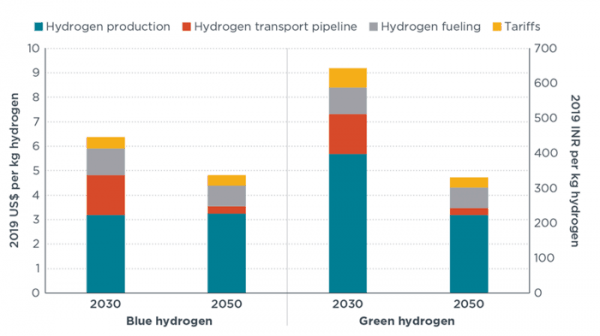India’s National Hydrogen Mission, launched in August 2021, seeks to scale up renewable electrolysis hydrogen (“green” hydrogen) production and use it in multiple sectors, including transportation. This is encouraging, as green hydrogen offers significant decarbonization potential. Still, whether green hydrogen gains significant uptake in India’s road transport sector will depend partly on consumer price, and this work estimates at-the-pump hydrogen costs in both 2030 and 2050.
The four key cost components of the at-the-pump price for hydrogen fuel are production cost, transport cost, fueling cost, and potential tariffs along the supply chain. The authors analyzed two hydrogen production pathways that could have significant potential in India: green hydrogen produced via water electrolysis powered by solar electricity and “blue” hydrogen produced from natural gas combined with carbon capture and storage. The study assumed the hydrogen is delivered via pipeline. The cities of Ahmedabad, Mumbai, and New Delhi served as case studies.
Results show that while green hydrogen is approximately 1.5 times more expensive than blue hydrogen in 2030, the two have a similar at-the-pump cost in 2050 (see figure). The gap narrows largely because of reduced costs for solar electricity and electrolysis and an increasing natural gas price. Notably, the per-kilogram cost of pipeline transport is almost six times less in 2050 than in 2030, as a result of increased capacity utilization and economies of scale. Critical to realizing these per-kilogram cost reductions is developing sufficient demand through policies and programs that support early market development of pipeline infrastructure and fuel cell electric vehicle manufacturing. While green hydrogen offers significant climate benefits, it is currently an emerging industry and policy supports would likely be needed to achieve cost reductions that make it competitive with other fuels.
Read more at: International Council on Clean Transportation
At-the-pump hydrogen costs averaged across Mumbail, Ahmedabad, and New Delhi. The blue hydrogen is produced from natural gas using SMR combined with CCS and the green hydrogen is produced from solar electricity through water electrolysis. (Photo Credit: International Council on Clean Transportation)


